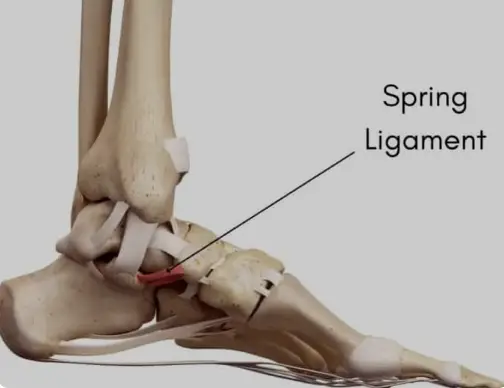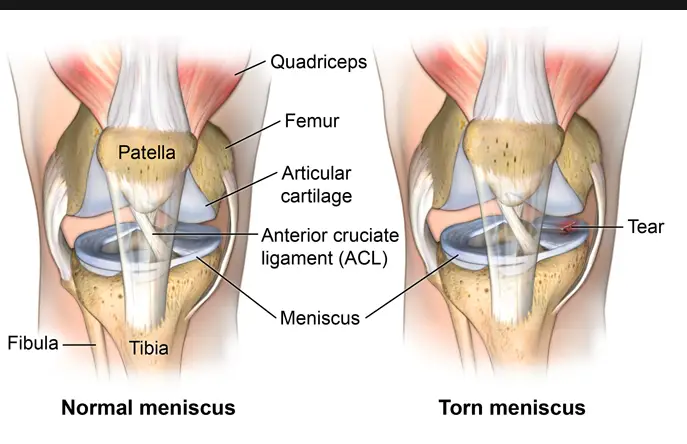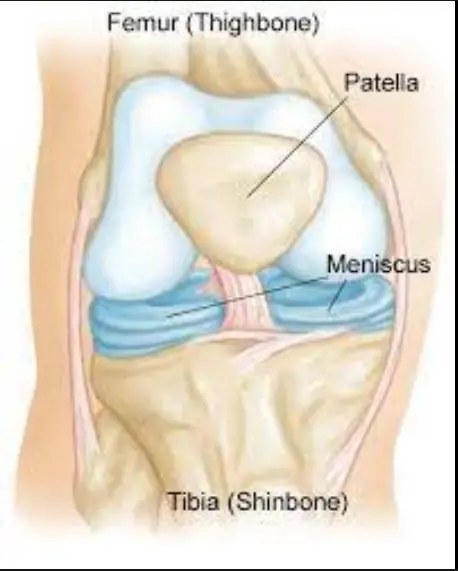The human body is a complex system where each component plays a pivotal role in maintaining overall health and function. Among these components, the meniscus and ligament are critical to the smooth operation of our joints, particularly in the knees. Despite their importance, confusion often arises regarding their distinct functions and structures.
The meniscus and the ligament are both vital to the knee’s stability and movement, but they serve different purposes. The meniscus is a rubbery, C-shaped disc that cushions your knee and absorbs shock between the shinbone and the thighbone. Ligaments, on the other hand, are tough, fibrous tissues that connect bones to other bones. The primary difference lies in their roles: menisci act as shock absorbers, while ligaments provide stability and prevent excessive movement.
A thorough understanding of these components is essential, not only for medical professionals but also for individuals engaged in activities that put stress on the knees. Knowing the roles and functions of the meniscus and ligaments can help in early diagnosis and treatment of related injuries, contributing to more effective recovery and rehabilitation strategies.

Meniscus Overview
Meniscus Definition
The meniscus is a fibrocartilaginous structure, present in pairs within each knee joint. It plays a critical role in maintaining joint stability, enabling smooth movement, and cushioning between the bones of the leg.
Function in the Knee
The primary function of the meniscus is to absorb shock and distribute the weight of the body evenly across the knee joint. This not only prevents the bones from grinding against each other but also helps in stabilizing the knee during various activities such as walking, running, and squatting. The meniscus achieves this by:
- Enhancing load transmission across the knee
- Absorbing the energy from impacts during motion
- Aiding in the lubrication of the joint
Structure Details
Each knee has two menisci: the medial meniscus and the lateral meniscus. These are C-shaped pieces of cartilage, thicker at the outer edge and thinner towards the inside. Their unique shape and composition allow them to conform to the motions of the knee. The outer part, known as the “red zone,” is rich in blood supply and thus has a higher healing potential, whereas the inner “white zone” lacks a blood supply, making injuries here more challenging to heal.
Ligament Overview
Ligament Definition
A ligament is a band of tough, elastic connective tissue that surrounds a joint to give support and limit the joint’s movement. Ligaments connect bones to other bones and are crucial in preventing excessive movement that could lead to joint injuries.
Key Functions
Ligaments perform several key functions within the joint, including:
- Maintaining bone alignment
- Stabilizing the joints during movements
- Preventing excessive movements that might lead to dislocation or injury
Structural Characteristics
Ligaments are composed mainly of long, stringy collagen fibers which give them a high tensile strength for bearing weight and sustaining tension. This structure allows ligaments to stretch considerably before reaching their breaking point.
Anatomical Locations
Meniscus in the Knee
The meniscus is specifically located between the thigh bone (femur) and the shin bone (tibia). Each knee joint houses a medial and lateral meniscus positioned on the top of the tibia, forming a concave surface that the femur bone can move on without friction.
Common Ligaments and Their Locations
Key ligaments within the knee include:
- Anterior Cruciate Ligament (ACL): Located in the center of the knee, it prevents the tibia from sliding out in front of the femur.
- Posterior Cruciate Ligament (PCL): Also in the center of the knee, it prevents the tibia from sliding backward under the femur.
- Medial Collateral Ligament (MCL): It runs along the inner part of the knee and prevents the knee from bending inward.
- Lateral Collateral Ligament (LCL): It runs along the outer knee and prevents the knee from bending outward.
Composition and Material
Meniscus Tissue Type
The meniscus is primarily made up of water and fibrocartilaginous tissue. This tissue is a complex mix of collagen fibers and proteoglycans, with the collagen providing structure and the proteoglycans helping in shock absorption.
Ligament Tissue Composition
Ligaments consist mostly of Type I collagen, a protein essential for providing tensile strength and the ability to stretch minimally under tension. This composition ensures that ligaments can withstand the forces of everyday movements without damage.

Injury and Diagnosis
Common Meniscus Injuries
Meniscus injuries typically occur during activities that involve twisting, turning, or a sudden change in direction. These injuries can range from mild to severe and are categorized into three types:
- Minor tear: Small tear where recovery is often quick.
- Moderate tear: Symptoms persist from a few weeks to a few months and may interfere with daily activities.
- Severe tear: Pieces of the torn meniscus can move into the joint space, causing severe pain and possibly leading to osteoarthritis.
Typical Ligament Injuries
Ligament injuries in the knee are most often associated with sports and physical activities. The most common are:
- ACL Injury: Often occurs during sports that require sudden stops and changes in direction.
- PCL Injury: Typically caused by a direct impact to the front of the knee, common in car accidents.
- MCL Injury: Usually results from a blow to the outer side of the knee, forcing it inward.
- LCL Injury: Less common and occurs when there is a force pushing the knee outward.
Diagnostic Approaches
To diagnose these injuries, healthcare providers rely on:
- Physical examination: Checking for swelling, pain, and range of motion.
- Imaging tests: MRI scans are the most effective, providing detailed images of both soft tissues and bones. X-rays, although less informative for soft tissues, help rule out bone fractures.
Treatment Options
Treating Meniscus Damage
Treatment for meniscus tears depends on the size and location of the tear. Options include:
- Conservative treatment: Rest, ice, compression, and elevation (RICE), along with anti-inflammatory medications.
- Physical therapy: Focuses on strengthening the muscles around the knee and improving flexibility.
- Surgery: Reserved for severe or non-healing tears, typically involving meniscus repair or meniscectomy (removal of the damaged portion).
Approaches to Ligament Repair
Ligament injuries, particularly those to the ACL, often require surgical intervention to regain full function. Treatment strategies include:
- Ligament reconstruction: Replacing the torn ligament with a graft.
- Physical therapy: Essential post-surgery for restoring strength and mobility.
- Bracing: Used to stabilize the knee during recovery.
Recovery and Rehabilitation
Meniscus Recovery Timelines
Recovery from a meniscus injury varies:
- Minor tears: Can heal within a few weeks with proper rest and care.
- Moderate tears: Might require several months, with a combination of conservative treatment and physical therapy.
- Severe tears: Recovery can take from 3 to 6 months, sometimes longer if surgery is involved.
Ligament Rehabilitation Processes
Rehabilitation from ligament surgery, especially for an ACL injury, follows a structured process:
- Early stage: Focus on reducing swelling and restoring knee motion.
- Middle stage: Gradual return to walking and light jogging.
- Final stage: Strengthening exercises and return to sports-specific activities.
Preventative Measures
Prevention Tips for Meniscus
To reduce the risk of meniscus injuries, consider the following:
- Strength training: Focus on the muscles of the thighs and lower legs to provide better support for the knees.
- Flexibility exercises: Regular stretching to maintain a good range of motion in the knees.
- Proper footwear: Ensures good alignment and support during activities.
Preventing Ligament Injuries
Preventing ligament injuries involves:
- Proper training techniques: Learning and using the correct form when performing high-impact sports.
- Adequate warm-up and cool-down: Reduces the risk of injury by preparing the muscles and ligaments for exercise.
- Use of protective gear: Knee braces can provide additional support during high-risk activities.
Frequently Asked Questions
What is a Meniscus?
The meniscus is a fibrocartilaginous structure in the knee that distributes body weight across the joint, reducing friction and damage during movement. It serves as a cushion for your knee joint, absorbing impact during weight-bearing activities.
How Many Ligaments are in the Knee?
The knee contains four primary ligaments: the Anterior Cruciate Ligament (ACL), Posterior Cruciate Ligament (PCL), Medial Collateral Ligament (MCL), and Lateral Collateral Ligament (LCL). These ligaments work together to stabilize the knee during movement.
Can Meniscus Tears Heal on Their Own?
Meniscus tears vary in their ability to heal, depending on their location and severity. Tears in the blood-rich outer third of the meniscus, known as the “red zone,” have a better chance of healing on their own or responding well to surgical repair.
What are Common Ligament Injuries?
Common ligament injuries include sprains and tears, such as ACL and MCL injuries, often occurring during activities that involve sudden stops and changes in direction, impacting athletes in sports like soccer, basketball, and skiing.
How are Meniscus and Ligament Injuries Diagnosed?
Diagnosis typically involves a physical examination, medical history analysis, and imaging tests such as MRI or X-ray to assess the extent of injury to the meniscus or ligaments and determine the appropriate treatment plan.
Conclusion
Recognizing the distinctions between the meniscus and ligament in the knee is crucial for anyone looking to maintain optimal joint health. While both are integral to the knee’s function, understanding their specific roles can significantly enhance the effectiveness of treatments for injuries. Awareness and education on this topic can lead to improved preventative measures and a decrease in the prevalence of knee injuries.
By fostering a deeper understanding of these vital components, individuals can better manage their health and mitigate risks associated with knee injuries, ensuring a higher quality of life and mobility. This knowledge is not only valuable for those actively engaged in sports but also for anyone interested in maintaining long-term joint health.

